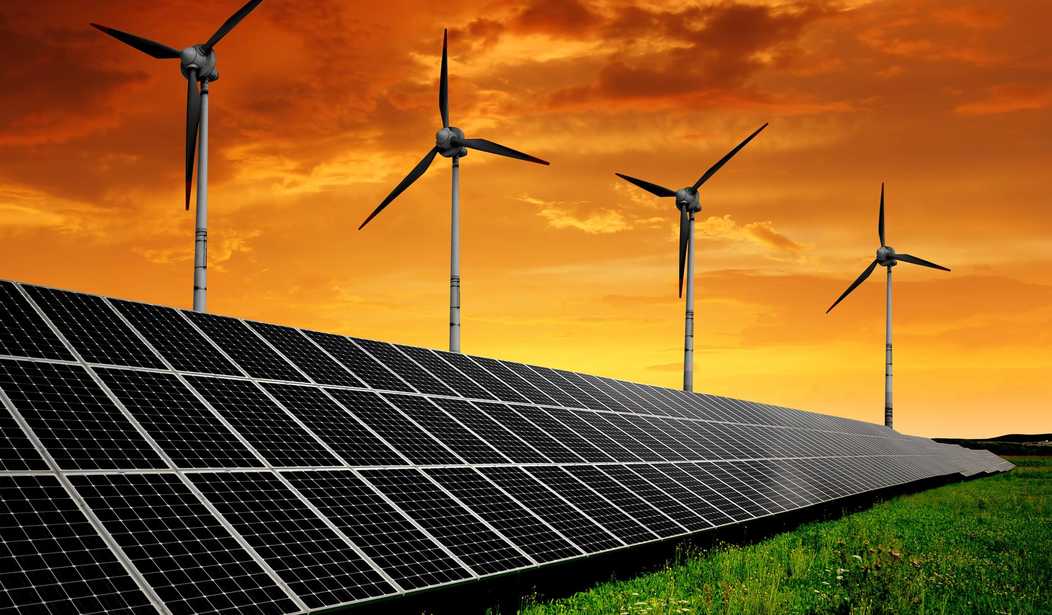A new report from the Department of Energy (DOE) painted a rosy picture for renewable energy, but Americans must not forget that any breakthroughs have come with a cost. The United States may produce more wind and solar energy than in previous years, but that increase must be understood in the context of government subsidies for those industries.
“Alternative energy technologies have been heavily subsidized for decades and even with the generous support from taxpayers, they haven’t penetrated the market as promised,” Nick Loris, research fellow in energy and environmental policy at the Heritage Foundation, told PJ Media on Monday. “If these technologies are as promising and cost-competitive as proponents of their use say they are, they shouldn’t need preferential treatment from the government.”
The DOE report shows “6 Charts that Will Make You Optimistic About America’s Clean Energy Future.” The charts show increasing energy output at decreasing cost for wind power and solar power, and they also show decreasing cost and increasing purchases for electric cars and LED light bulbs.
“The Department of Energy’s information tells a bit of a different story when you look closely,” Dan Simmons, vice president for policy at the Institute for Energy Research (IER), told PJ Media on Monday. Simmons noted that while the cost of land-based wind energy fell overall since 1980, it actually increased more than 40 percent from 2002 to 2010.
In July, National Review‘s Robert Bryce reported that the wind energy industry has received $176 billion in local, state, and national subsidies since 2000. Despite this, according to the DOE graph, wind was actually cheaper in 2002 than it was in 2015.
“It appears that tens of billions in subsidies for wind made wind more expensive,” Simmons quipped.
The IER expert also noted that the DOE report failed to include the growth of other energy sources. “Even with the subsidies the Obama administration has provided for wind and solar, natural gas production is still outpacing the growth in wind and solar generation,” Simmons noted. The DOE data shows the energy produced by natural gas grew more than two-and-a-half times faster than wind and solar energy between 2008 and 2015.
It’s also important to note that even with the subsidies the Obama administration has provided for wind and solar, natural gas production is still outpacing the growth in wind and solar generation. In fact, DOE data show that the energy produced by natural gas grew more than two and a half times faster than wind and solar from 2008 through 2015.
But there is another hidden cost to wind and solar, one you may not think of.
But there are even more hidden costs to these technologies than the subsidies, the energy expert said. When solar panels or wind farms are actually producing electricity, “it means that more reliable sources must decrease their output accordingly. Catering to unreliable wind and solar makes those reliable sources more expensive to operate, which ultimately leads to more expensive electricity for American families and businesses.”
“Cost estimates that don’t include these costs don’t provide a complete picture of how expensive wind and solar really are,” Simmons explained. He even argued that “any decreases in the cost of building wind turbines or solar panels aren’t especially relevant because [these technologies] still face reliability issues.”
The rosy renewable energy numbers presented by the DOE should not distract from the energy improvements from more traditional sources, Simmons added. “Technological progress such as through hydraulic fracturing and directional drilling has given us access to vast amounts of energy resources that weren’t previously affordable,” he explained. “While the DOE touts the reductions in the cost of solar, we should also note the reductions in the cost of producing natural gas and oil from areas that were previously prohibitively expensive.”
“Our energy future is bright as long as people have the freedom to innovate,” Simmons concluded. A focus on wind and solar may have boosted those technologies in recent years, but it is important for different energy sectors to compete freely in an energy market which does not play favorites. The best way for American families to get the most energy at the cheapest price is to let wind and solar compete with oil, coal, natural gas, and nuclear. Americans will benefit even more if the markets are more free.









Join the conversation as a VIP Member